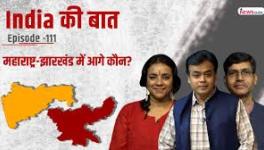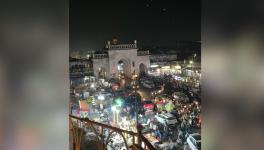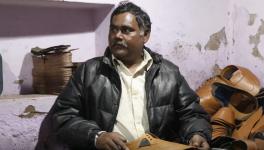Why is Unnao Making Headlines for Crimes Against Women?
Three teenage dalit girls, who are cousins are found unconscious in an agricultural field in a village in Unnao district of Uttar Pradesh in February. They are rushed to a primary health centre where doctors declare two of the girls dead. The survivor is rushed to a hospital in Unnao, and from there to Kanpur for better treatment.
The news is prominently covered by all major dailies and television channels. The police swing into action and after a few days, arrest two young men. Police authorities said one of the girls had spurned the advances of one of the men. The jilted man then offered the girl water laced with pesticide to avenge the rejection, but her two cousins also drank the same water and died from poisoning.
Now that the case has been solved, news on Unnao has once again vanished from the newspapers published from Kanpur and Lucknow.
People who regularly read newspapers know that it will not be too long before Unnao will once again be in the news; obviously for a wrong reason.
Unnao shares its borders with two major cities – Kanpur and Lucknow. Unnao downtown is small, congested and crowded. Streets there are narrow and clogged; buildings constructed in an unplanned way. But as a district, Unnao is vast. You will travel kilometre after kilometre, hour after hour through agriculture fields but still find yourself in the district.
For the past five years or so, the district has been in the limelight for wrong reasons, especially for crime against women.
Consider a few incidents:
In March 2017, the eyes of a gang-rape victim were gouged out by the relatives of the accused persons.
A rape victim was burned alive by the accused in December 2019.
In the latest incident, an attempt was made on the lives of the three girls and two of them died.
But Unnao hogged the limelight when a 17-year-old girl accused Kuldeep Singh Sengar, a sitting legislator of the Bharatiya Janata Party (BJP), of raping her along with his accomplices on June 4, 2017. There is also a Wikipedia page on the incident.
The opening paragraph of the Wikipedia page on Kuldeep Singh Sengar says, “Kuldeep Singh Sengar is a former Member of legislative assembly, and belonged to Bhartiya Janata Party from Bangarmau, Uttar Pradesh, India who has been convicted of rape, murder, attempt to murder, criminal conspiracy and criminal intimidation. He is the main accused in the Unnao rape case and was booked under the POCSO Act. He is also accused of killing three people, including the victim's father in police custody and later her aunts by a conspired truck accident.”
Is something wrong with Unnao that horrifying incidents of crime, especially against women, are recurring there?
Veteran journalist Atul Chandra who lives in Lucknow says Unnao was never considered a safe place and the police had earlier identified it as a crime-prone district of Uttar Pradesh. He said Unnao, along with districts like Mainpuri, Etah and Etawah, was part of a belt in Uttar Pradesh that was once infamous for crime.
Chandra said, “The question is, ‘Is Unnao still a crime prone district in police records?’ If yes, then normal policing won’t do. A new and special strategy of policing has to be evolved to protect people, especially women against crime.”
Vikram Singh, former Director General of Police of Uttar Pradesh, says the incident in which Sengar was an accused, clearly shows how people with money and influence can easily misuse law and escape legal action after committing a crime in the state.
“The police swung into action only after the victim’s self immolation bid in front of the chief minister’s residence. Even after the self immolation bid, the police, instead of ensuring that the victim got justice, tried to shield the accused,” says Singh.
Singh adds that after the 2012 Nirbhaya incident, some amendments were made in the law and provisions were included for strong action against police officials who neglected crime against women or a woman’s complaint.
“In Uttar Pradesh, has action been taken against a police official who failed to provide protection to a woman?” he asks.
Singh believes crime, especially against women, is rising in every district of Uttar Pradesh and not in Unnao alone. “Are incidents of crime not taking place in districts like Mainpuri, Etah, Hathras, Badayun?” Singh asks and adds, “Incidents in Unnao get traction because the district is close to Lucknow.”
Singh said the crime graph in Uttar Pradesh was rising because policing had completely failed.
“I have worked in different capacities in the police force and I ensured the strictest action against molesters and serial offenders against women,” Singh said. “The method of policing has to change.”
Kanpur became the nerve centre of the independence movement as Bengal was partitioned and Delhi, instead of Calcutta, became the capital of British India. Freedom fighters like Chandrashekhar Azad and Bhagat Singh frequently visited Kanpur.
Downtowns of Kanpur and Unnao are separated by a mere distance of just 20 kilometres and because of the close vicinity; the latter also became a hotspot of the freedom struggle.
Subhash Chandra Bose spent three days in Unnao in 1937.
The district also became a hub of communism and was so much influenced by the communist movement that a village was named Marx Nagar after Karl Marx. The village still retains the name in official records.
Dr TB Singh who teaches sociology in Kanpur University feels Unnao’s topography is conducive for crime and criminals.
“The district is vast, mostly rural and has thick vegetation. The south-west border is some 150 kilometres along which runs the Ganga and has ravines. Remote and sparsely populated areas, thick vegetation, ravines will encourage crime,” says Singh. “Moonshine making is like a cottage industry in the ravines and incidents of people dying after consuming the illegally brewed liquor is not uncommon.”
Unnao, apart from Kanpur and Lucknow, also has a common border with five other districts – Raebareli, Fatehpur, Kanpur Dehat, Kannauj and Hardoi districts.
“As Unnao shares its borders with so many districts, maybe it is easy for a criminal to escape from Unnao after committing a crime,” says Singh.
He says smartphones and social media were playing a major role in incidents of crime in places like Unnao hitting the headlines. Singh adds,“Crime is taking place in every district and not just in Unnao. It is also quite possible that people in Unnao have become bold and vocal as they saw Kuldeep Singh Sengar, an influential person, being punished.”
Leaders of all prominent political parties of Uttar Pradesh have represented Unnao in Parliament in the past. The Congress party won the Unnao seat from 1952 to 1977. People elected a Janata Party leader in 1977. The Congress bounced back to power in the general elections in 1980 and 1984. The Janata Dal emerged victorious in 1989. The Bharatiya Janata Party candidate won from Unnao for the first time in 1991 and the party won in 1996 and 1998 elections as well. The Samajawadi Party candidate won in 1999 and the Bahujan Samaj Party candidate in the elections in 2004. People voted for the Congress in 2009. Saakshi Maharaj of the BJP won the seat in 2014 and 2019.
Veteran journalist Askari Zaidi, who belongs to Unnao, said people of the district have failed to connect with their elected representatives.
“People with grievances approach elected representatives. But in Unnao, many of the representatives have criminal cases against them. The locals, particularly in the Kuldeep Singh Sengar case, saw that the administration and police were siding with him. The sitting Member of Parliament Saakshi Maharaj is not a local of Unnao. So, people neither have a connect nor have faith in the public representatives. All these factors along with the indolent behavior of administration and police aggravate the situation,” says Zaidi.
He says the caste conflict also acts as a catalyst to give Unnao a bad name. “Unnao is dominated by people of upper castes as well as those of lower castes. Hence, caste conflict always prevails. That conflict is quite common throughout Uttar Pradesh and even in Bihar. But because of the ineffectiveness of the police, particularly in Unnao, things often go out of hand,” said Zaidi.
Annu Tandon represented Unnao in Parliament from 2009 to 2014. She was then a Congress leader, but recently joined the Samajwadi Party.
“It is wrong to say crime cases, especially those against women are increasing only in Unnao. They are increasing particularly in Uttar Pradesh and India in general,” says Tandon. “But the media has specifically highlighted the issues of Unnao. Also, as I am vocal and want to see that a victim gets justice, cases were in the limelight.”
She says that lack of strong laws has encouraged criminals. “The government must be strong enough to instantly nail an offender, especially in cases related to women so that others are deterred.”
In the north-east of Unnao is Lucknow that was once the capital of the Awadh kingdom, during British period of the United Provinces and after independence of Uttar Pradesh. In its south-west is Kanpur where industrialisation began in the last quarter of the 19th century.
Unnao has benefitted neither from Lucknow nor from Kanpur.
People of Unnao seek jobs either in Lucknow or in Kanpur. A few tanneries are there but they generally employ people from Kanpur.
“Unnao somehow missed the attention it should have got. Lucknow is developing but Unnao remains unaffected,” says Chandra, the journalist. “Ghaziabad and Noida have developed because they were included in the National Capital Region. Thane was planned to be an extended part of Mumbai. A Kanpur-Unnao-Lucknow industrial corridor can be developed.”
Askari Zaidi says that Unnao has remained sandwiched between Lucknow and Kanpur and got nothing. He adds, “Kanpur was once a major textile centre of India but most of the industries have closed. So you can’t expect Unnao to get benefits from the industries of Kanpur. A handful of tanneries that produce branded goods have their manufacturing units in Unnao but they are head-quartered either Kanpur or in Mumbai.”
Professor TB Singh says people of Unnao who were affluent or could afford to move, have shifted either to Lucknow or to Kanpur. “Kanpur or Lucknow has a chain of public schools. You won’t find their branches in Unnao,” he says.
The three Unnao girls who were found unconscious in an agriculture field had gone there to collect fodder for their cattle and they used to do so twice in a day. It means they did not go to school.
The survivor was shifted to Kanpur for treatment. It proves Unnao lacks hospitals with advanced facilities. Overall, the place has stayed backward.
Annu Tandon says, “You can’t change a place, the mindset of its people overnight. It takes time.”
The writer is an independent journalist based in Kanpur.
Get the latest reports & analysis with people's perspective on Protests, movements & deep analytical videos, discussions of the current affairs in your Telegram app. Subscribe to NewsClick's Telegram channel & get Real-Time updates on stories, as they get published on our website.
























